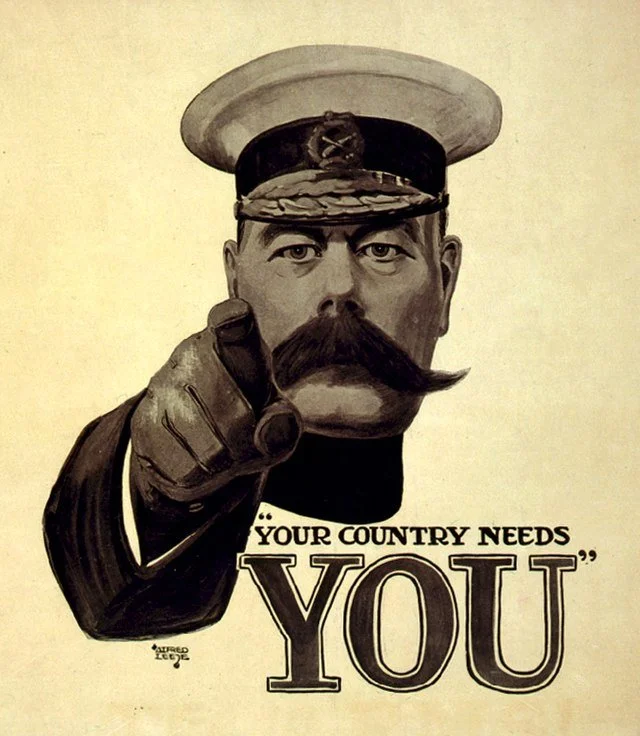The History of Art as Propaganda
Whilst propaganda has long been synonymous with furthering ideologies through speeches, writing, and reporting, it also has a powerful history of intentionally manipulating visual art to express political sentiments. As art is a form of expression, its commentary on social and political realities enables the medium to be a catalyst for change. Recalling the history of political propaganda, one can understand how intentionally propagated images furthered states’ political sentiments through visually communicating messages.
World War I
For example, World War I is remembered as the first war where mass media played a significant role in the facilitation of news from the battlefield to the Home Front. The event marked the beginning of the widespread use of political propaganda as a tool to shape public opinion towards states’ participation in the war through posters encouraging community involvement as well as posters that vilified the enemy. Political propaganda’s malleability as a means of advancing political ideologies is evident through the visual history of posters endorsing local engagement in the war efforts as well as posters distorting the public perception of the enemy.
A prime example of political propaganda rallying patriotic support is expressed in the British Army’s ‘Your Country Needs YOU’ poster. Starring Lord Kitchener, a revered senior Army officer at the time, this iconic poster was expertly designed by artist Alfred Leete to evoke both patriotic strength and guilt in those eligible to enlist in World War I. Pointing at the reader in an intimidating fashion coupled with the capitalised ‘YOU’, this poster was rendered to appear as if Lord Kitchener was personally recruiting able viewers to join the soldiers on the battlefield.
The archetypal poster resulted in an enlistment frenzy in Great Britain, and was later repurposed by a plethora of states to initiate the same sense of nationalism. The most notable adaption was the United States’ ‘Uncle Sam’ poster that furthered the same sentiments of nationalism to gather recruits for the American army. Mirroring Leete’s original, artist James Montgomery Flagg’s poster included the same pointed finger, daunting stare, and emphasis on the ‘YOU’ to persuade civilians to do their part in the war effort and fight for the American army.
World War II
Propaganda posters in World War II frequently rallied nationalism through malicious depictions of the enemy. The Nazis, for example, relied on construed portrayals of Jews, Romani peoples and homosexuals to elicit support for Hitler’s campaign for a strong, homogenous Germany. Here, propaganda contributed to the manipulation of the public perception towards these “undesirables”, especially when juxtaposed to propaganda depicting—and thus furthering—Hitler’s messianic portrayal.
The United States was also guilty of exploiting the communicative qualities of propaganda to devise hateful sentiments towards the Japanese as a reaction to Japan’s attack on Pearl Harbour during World War II. Like the Nazis, American propaganda produced racist imagery of Japanese people with distorted, exaggerated features. Thus, posters fostering hatred for the enemy by dehumanising their portrayals exemplify how nationalistic sentiments were inadvertent consequences of slanderous wartime propaganda.
The Cold War
Comparable with the trope of vilifying the enemy during World War II, American propaganda in the Cold War tried to demonise the Communist political system through posters advertising the power structure as a threat to the American lifestyle. Whilst anti-Communist propaganda was mainly embedded in movies, books and magazines, propaganda posters were nevertheless essential tools for the American government to advertise the American ideals and values that were alleged to be at risk.
Henceforth, posters combatting the ideologies embedded in the USSR and the People’s Republic of China (PRC) were published to cultivate fear in the American viewers. Propaganda posters intentionally constructed the image of Communism in a harrowing manner, which played on people’s emotions and visually communicated the threats Communism posed to American ideals. By effect, propaganda in the Cold War was able to influence the audience’s opinion of Communism as an evil that must be defeated, which ultimately evoked nationalistic support for America’s political agenda.
By encouraging mobilisation, as well as facilitating an attitude of hatred against the enemy and opposing political power structures, propaganda posters were persuasive masterpieces essential to the strengthening of nationalism in wartime politics. As demonstrated, propaganda was a key strategy deployed in World War I, World War II, and the Cold War to further states’ agendas, and has now manifested into a vital aspect of states’ foreign policy. Thus, the utilisation of the visual medium to clearly communicate political sentiments has proven to be successful, for better or for worse.
Image courtesy of Library of Congress via Wikimedia, ©2010, some rights reserved.
The views and opinions expressed in this article are those of the author and do not necessarily reflect those of the wider St. Andrews Foreign Affairs Review team.



